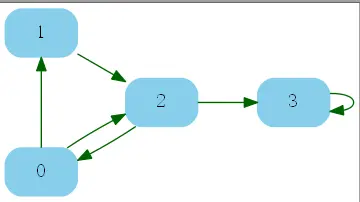图的广度优先搜索和深度优先搜索(邻接链表表示)
| 阿里云国内75折 回扣 微信号:monov8 |
| 阿里云国际,腾讯云国际,低至75折。AWS 93折 免费开户实名账号 代冲值 优惠多多 微信号:monov8 飞机:@monov6 |
邻接链表
邻接表表示法将图以邻接表(adjacency lists)的形式存储在计算机中。所谓图的邻接表,也就是图的所有节点的邻接表的集合;而对每个节点,它的邻接表就是它的所有出弧。邻接表表示法就是对图的每个节点,用一个单向链表列出从该节点出发的所有弧,链表中每个单元对应于一条出弧。为了记录弧上的权,链表中每个单元除列出弧的另一个端点外,还可以包含弧上的权等作为数据域。图的整个邻接表可以用一个指针数组表示。例如下图所示,邻接表表示为

邻接链表
广度优先搜索
基本思路
- 把根节点放到队列的末尾。
- 每次从队列的头部取出一个元素,查看这个元素所有的下一级元素,把它们放到队列的末尾。并把这个元素记为它下一级元素的前驱。
- 找到所要找的元素时结束程序。
- 如果遍历整个树还没有找到,结束程序。
代码实现
//http://www.geeksforgeeks.org/breadth-first-traversal-for-a-graph/
// Program to print BFS traversal from a given source vertex. BFS(int s)
// traverses vertices reachable from s.
#include<iostream>
#include <list>
using namespace std;
// This class represents a directed graph using adjacency list representation
class Graph
{
int V; // No. of vertices
list<int> *adj; // Pointer to an array containing adjacency lists
public:
Graph(int V); // Constructor
void addEdge(int v, int w); // function to add an edge to graph
void BFS(int s); // prints BFS traversal from a given source s
};
Graph::Graph(int V)
{
this->V = V;
adj = new list<int>[V];
}
void Graph::addEdge(int v, int w)
{
adj[v].push_back(w); // Add w to v’s list.
}
void Graph::BFS(int s)
{
// Mark all the vertices as not visited
bool *visited = new bool[V];
for(int i = 0; i < V; i++)
visited[i] = false;
// Create a queue for BFS
list<int> queue;
// Mark the current node as visited and enqueue it
visited[s] = true;
queue.push_back(s);
// 'i' will be used to get all adjacent vertices of a vertex
list<int>::iterator i;
while(!queue.empty())
{
// Dequeue a vertex from queue and print it
s = queue.front();
cout << s << " ";
queue.pop_front();
// Get all adjacent vertices of the dequeued vertex s
// If a adjacent has not been visited, then mark it visited
// and enqueue it
for(i = adj[s].begin(); i != adj[s].end(); ++i)
{
if(!visited[*i])
{
visited[*i] = true;
queue.push_back(*i);
}
}
}
}
// Driver program to test methods of graph class
int main()
{
// Create a graph given in the above diagram
Graph g(4);
g.addEdge(0, 1);
g.addEdge(0, 2);
g.addEdge(1, 2);
g.addEdge(2, 0);
g.addEdge(2, 3);
g.addEdge(3, 3);
cout << "Following is Breadth First Traversal "
<< "(starting from vertex 2) n:";
g.BFS(2);
return 0;
}深度优先搜索
基本思路
- 访问顶点v;
- 依次从v的未被访问的邻接点出发,对图进行深度优先遍历;直至图中和v有路径相通的顶点都被访问;
- 若此时图中尚有顶点未被访问,则从一个未被访问的顶点出发,重新进行深度优先遍历
代码实现
//http://www.geeksforgeeks.org/depth-first-traversal-for-a-graph/
// C++ program to print DFS traversal from a given vertex in a given graph
#include<iostream>
#include<list>
using namespace std;
// Graph class represents a directed graph using adjacency list representation
class Graph
{
int V; // No. of vertices
list<int> *adj; // Pointer to an array containing adjacency lists
void DFSUtil(int v, bool visited[]); // A function used by DFS
public:
Graph(int V); // Constructor
void addEdge(int v, int w); // function to add an edge to graph
void DFS(int v); // DFS traversal of the vertices reachable from v
};
Graph::Graph(int V)
{
this->V = V;
adj = new list<int>[V];
}
void Graph::addEdge(int v, int w)
{
adj[v].push_back(w); // Add w to v’s list.
}
void Graph::DFSUtil(int v, bool visited[])
{
// Mark the current node as visited and print it
visited[v] = true;
cout << v << " ";
// Recur for all the vertices adjacent to this vertex
list<int>::iterator i;
for (i = adj[v].begin(); i != adj[v].end(); ++i)
if (!visited[*i])
DFSUtil(*i, visited);
}
// DFS traversal of the vertices reachable from v.
// It uses recursive DFSUtil()
void Graph::DFS(int v)
{
// Mark all the vertices as not visited
bool *visited = new bool[V];
for (int i = 0; i < V; i++)
visited[i] = false;
// Call the recursive helper function to print DFS traversal
DFSUtil(v, visited);
}
int main()
{
// Create a graph given in the above diagram
Graph g(4);
g.addEdge(0, 1);
g.addEdge(0, 2);
g.addEdge(1, 2);
g.addEdge(2, 0);
g.addEdge(2, 3);
g.addEdge(3, 3);
cout << "Following is Depth First Traversal (starting from vertex 2) n:";
g.DFS(2);
return 0;
}运行结果

输入

广度优先搜索

深度优先搜索
也可以试试从其他定点(0,1,3)开始遍历☺
参考
初识图,图的存储(邻接矩阵,邻接链表)和深搜遍历算法与数据结构(2)——图的表示法与常用的转化算法
| 阿里云国内75折 回扣 微信号:monov8 |
| 阿里云国际,腾讯云国际,低至75折。AWS 93折 免费开户实名账号 代冲值 优惠多多 微信号:monov8 飞机:@monov6 |

